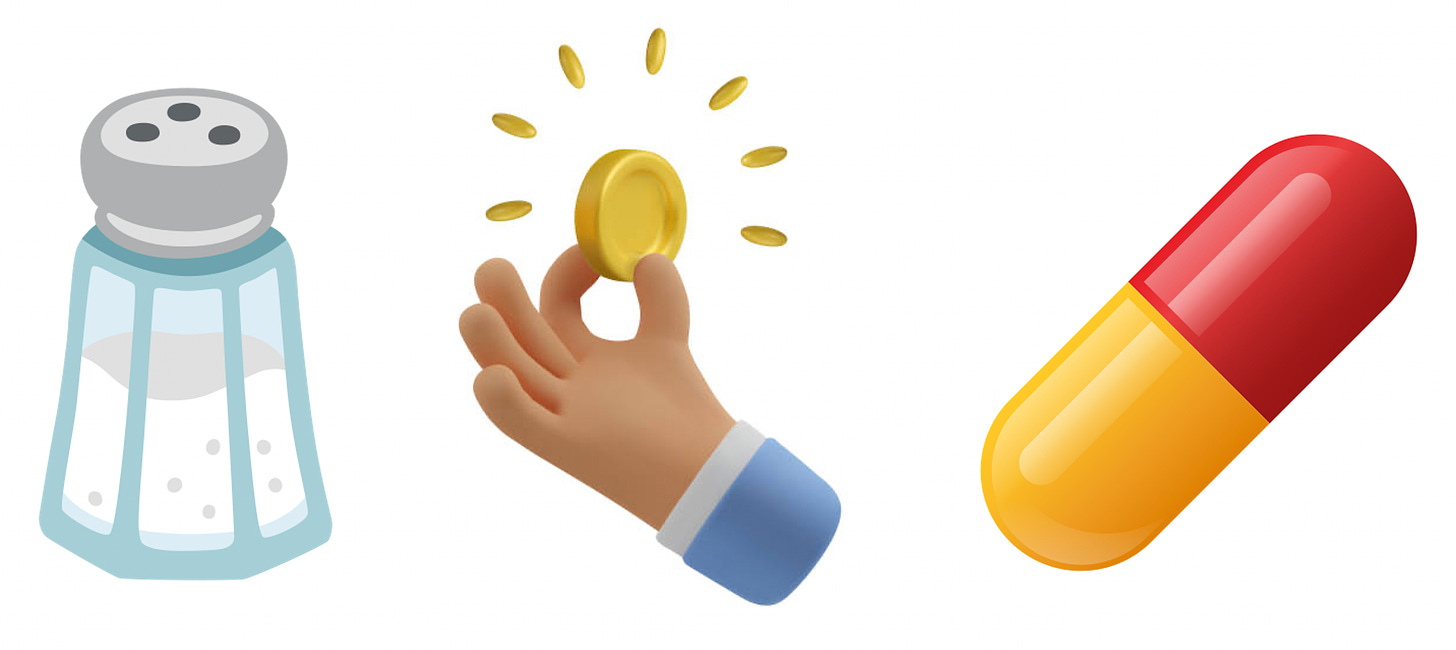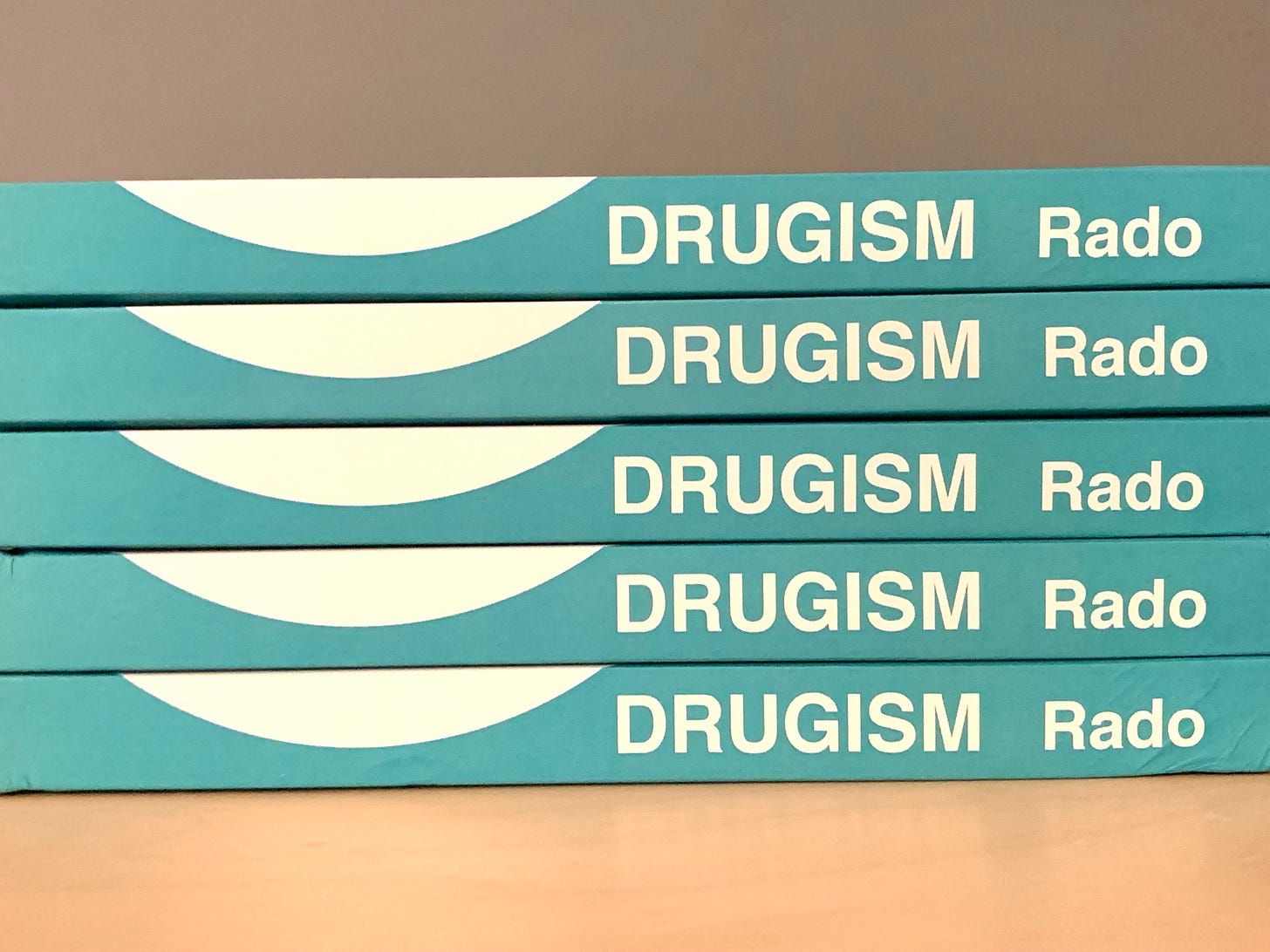Salt crystals, left; money, center; amphetamine crystals, right. See photo credits below.
The following is an excerpt from p. 55-58 of Chapter 1, “Precious Crystals: What Salt Teaches Us About Drugs” from my new book, Drugism (2022):
[This excerpt is the 1st in a 4-part series exploring the parallels between history’s salt merchants and today’s drug dealers, both legal and illegal.]
The similarities between merchants of salt and merchants of drugs are practically countless. This is true for both the legal and illegal versions of each trade. The degree to which the lives and business practices of salt traders and drug traffickers overlap can be, quite frankly, overwhelming.
In reviewing these characteristics, we will see them vividly reflected across cultures and generations. To illustrate these similarities we will consider Arthur Sackler, the infamous advertising-executive-turned-pharmaceutical-baron behind Purdue Pharmaceuticals, whose life and company bore striking resemblance to those of the most successful salt merchants of Qing-era China, such as Bao Zhidao. We will then learn about the illegal salt smugglers in gabelle-era France and India before its independence, whose lives were uncannily similar to those of today’s illegal drug dealers.
First, however, we should note the frequency with which salt has appeared alongside other drugs in history. In China for hundreds of years, salt and tea have been sold in close proximity. The Huizhou region, which came to be known for its salt merchants, also had a thriving tea trade.[i]In precolonial India, salt was traded for cannabis and opium.[ii] Moving westward, we find that Timbuktu, Mali was historically a center for both salt and tobacco trade.[iii] In Italy, as we saw above, both salt and tobacco were heavily taxed by the Italian state and sold in similar fashions. We also saw earlier how salt, opium, and wine were preliminary sources of revenue for the British in India and the French in Vietnam.
With salt and other drugs in such close proximity through history, it is no wonder why the industries around them have so many parallels.
With salt and other drugs in such close proximity through history, it is no wonder why the industries around them have so many parallels. Indeed, even the lifestyles of merchants of salt and drugs share similarities. This is as true for those who have practiced their respective trades legally as it is for those who have done so illegally.
The similarities among legal merchants of salt and drugs are plentiful, and here we will cover five. Among their illegal counterparts, the similarities are so numerous that they are difficult to even quantify. But for the sake of simplicity, I have grouped these latter characteristics into five loose clusters.
Let us start with the five noteworthy similarities between those who have sold salt and drugs legally. They are:
1. Unique class status of merchants
2. Revolving door between industry and state
3. Social alliance among industry, state, and scholars
4. Large, public displays of wealth and legacy
5. Art collector identity
1. Unique class status of merchants
The first of these is characteristics is the unique class status of salt and drug merchants. Both salt merchants and pharmaceutical executives have typically come from the ranks of businesspeople. However, through their business, they amass enough wealth to rival the ruling class. For example, in China, the Qing dynasty saw a rapid rise in the wealth and power of merchants, and it was salt merchants who led the way.[iv] During this period, state-sanctioned salt merchants “held the largest aggregated wealth of any commercial industrial group in the [Chinese] empire.”[v]
Considering the size and power of China, it is possible that these Chinese salt merchants may have been the wealthiest merchants in the world at the time. Salt historian Yulian Wu notes that this rise in the merchant class seen in Qing-era China shares a striking similarity with “the rapid rise of merchants” seen “in early modern Europe.”[vi] The same rapid ascent from merchant class to ruling class can be seen once again in the lives of modern pharmaceutical executives.
Qing Dynasty salt barons were the wealthiest merchants in China and among the wealthiest in the world.
Take as an example Arthur Sackler, who was born into a working-class family in New York City. His parents immigrated to the US from Eastern Europe. His father owned a small store and had difficulty supporting the family. In order to help the family remain financially afloat, the young Arthur began to sell advertisements for newspapers. He had a knack for selling ads and eventually rose to the top of a New York City-based advertising agency that specialized in drug ads.[vii] With money he made from drug ads, he acquired a small pharmaceutical firm known then as the Purdue Frederick Company. Under the leadership of Sackler and his family, Purdue Pharma (the now-notorious name by which the company was later known) became one of the most lucrative pharmaceutical companies in the world thanks in large part to their opioid sales.[viii]
Just as salt merchants ushered in a rise in the power of the merchant class in Qing-era China, in modern times the Sacklers have “transform[ed] the pharmaceutical industry” and “heralded an era of increasing financial entanglements between drug companies and doctors,” to quote journalist Barry Meier, who broke the story about Purdue’s corruption in 2001.[ix] As a result of this process, families like the Sacklers are some of the wealthiest in the world and boast deep connections with the state, despite extensive legal entanglements.
2. Revolving door between industry and state
This brings us to the next major similarity among ancient salt merchants and today’s pharmaceutical executives: both have a mutually dependent relationship with the state, something today’s commentators call a “revolving door.” While there were probably not any actual revolving doors in the entrances of ancient Chinese imperial buildings and salt businesses, individuals often passed from the emperor’s bureaucracy into the salt industry and vice versa. Some research suggests that this practice began with China’s first salt tax around the twentieth century BCE, when a semilegendary Emperor Yu is thought to have appointed a state employee to run the imperial salt monopoly.[x]
And there have been countless examples since the twentieth century BCE of state officials moving into the salt business and vice versa. Looking again at China, we find that in the eighteenth-century Manchu dynasty, salt merchants were given official positions in exchange for aiding in the various operations of the empire.[xi] Similarly, the emperor’s own bondservants were appointed to roles in the salt monopoly.[xii]This exchange of personnel and power allowed both salt merchants and state officials to further pursue their respective agendas.[xiii]
A similar pattern is found in today’s pharmaceutical industry. Returning once again to the case of Purdue Pharmaceuticals, we find many examples. For example, the FDA official who approved the release of Purdue’s OxyContin in 1995, Curtis Wright IV, was subsequently hired by the company. According to Meier, Wright made $379,000 in his first year at Purdue. Not long after, Purdue hired several retired DEA agents as well as police officers. They also hired former New York City mayor Rudolph Giuliani and Maine’s former Attorney General, Jay McCloskey, to help them with their legal issues.[xiv] In sum, a wealthy pharmaceutical company hired former FDA and DEA officials, a former Attorney General, a former mayor, and several police officers to their ranks to help them conquer the courts and the market. Just as numerous imperial bureaucrats received positions in the salt business, today many government officials are recruited by large corporations, pharmaceutical and otherwise.
And Purdue is far from the only company to have done this. The practice is widespread. So widespread, in fact, that it has become standard practice for whoever heads the FDA to leave the agency for a pharmaceutical company. In the last forty years, there has been one, single FDA commissioner who did not go on to work for a pharmaceutical company after their time at the agency. His name is David Kessler. Besides Kessler, every other FDA commissioner since Ronald Reagan’s first year in office has been unable to resist the hoards of cash offered to them by Big Pharma.[xv] The metaphorical revolving door sure gets a lot of foot traffic.
It is standard practice for whoever heads the FDA to leave the agency for a pharmaceutical company.
Endnotes
[i] Wu, 203n.
[ii] Kurlansky, 336.
[iii] Ibid., 50.
[iv] Wu, 4; Hucker, 351.
[v] Multhauf, 13.
[vi] Wu, 24.
[vii] Meier, Pain Killer, 42 and 46.
[viii] Ibid., 183.
[ix] Ibid., 47.
[x] The evidence for this particular point is disputed by some; Multhauf, 12.
[xi] Wu, 196.
[xii] Ibid., 16.
[xiii] Ibid., 4.
[xiv] Meier, 76-77, 140-145 and 164.
[xv] Foley, “Trust issues deepen…”
Sources
Foley, Katherine Ellen. “Trust issues deepen as yet another FDA commissioner joins the pharmaceutical industry.” Quartz, July 1, 2019.
Hucker, Charles O. China’s Imperial Past: An Introduction to Chinese History and Culture. Stanford University Press, Stanford, CA. 1975.
Kurlansky, Mark. Salt A World History. Penguin Books, 2002. New York, NY.
Meier, Barry. Pain Killer: An Empire of Deceit and the Origin of America’s Opioid Epidemic. Random House. New York, NY. 2018 [originally published in 2003].
Multhauf, Robert P., Neptune’s Gift: A History of Common Salt. The Johns Hopkins University Press, Baltimore, MD. 1995 [originally published in 1978].
Wu, Yulian. Luxurious Networks: Salt Merchants, Status, and Statecraft in Eighteenth-Century China. Stanford University Press. Stanford, CA. 2017.
Photo credits
Salt crystals from Crystalverse at https://crystalverse.com/cluster-of-table-salt-crystals/
Pile of coins from 123RF on Pinterest at https://www.pinterest.com/pin/2955555986274862/
Amphetamine crystals from The Alcohol and Drug Foundation at https://adf.org.au/drug-facts/amphetamines/
#drugism #drugs #drug #salt #opioid #opioids #pharmaceutical #prescription #medicine #capitalism #power #money #drugpolicy #politics #economics







